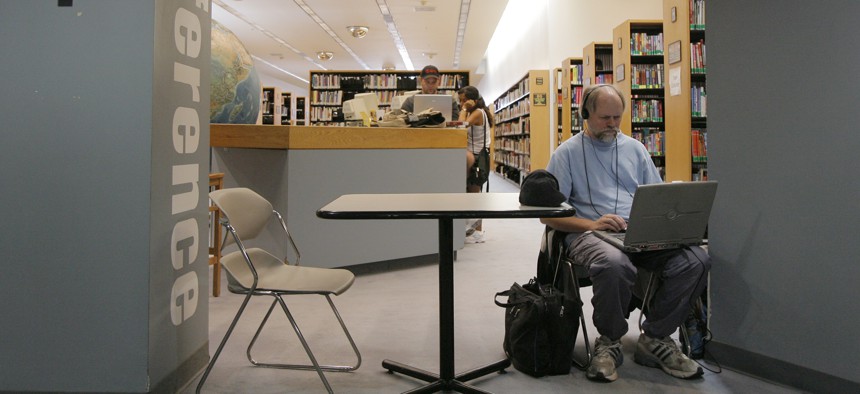Frustrated by Flawed Broadband Maps, States Are Trying to Create Their Own

Jeff Quitney, 50, surfs the internet using free Wi-Fi service at the Las Vegas Library in Las Vegas, Monday, Sept. 10, 2007. AP Photo/Jae C. Hong
The Federal Communications Commission’s broadband maps underestimate the number of households that lack internet service. State agencies are trying to gather better data.
State officials tasked with overseeing expansion of broadband to their residents say it is paramount to have accurate information about where infrastructure and service is lacking.
But because connectivity data collected by the Federal Communications Commission often overestimates broadband’s reach, many states are trying to gather their own data, sometimes going door-to-door to query residents, to better understand service gaps.
For North Carolina’s Department of Information Technology, data collection is now a primary objective because “there is so much money on the table,” said Jeff Sural, director of the agency’s Broadband Infrastructure Office.
“We want to make sure North Carolina gets its fair share and we think the current approach does not address the granularity needed to adequately distribute these funds,” Sural said, discussing the matter Tuesday during a Pew Charitable Trusts event on broadband.
The state is working to overlay FCC data with information gleaned directly from service providers and what is reported by residents to understand where best to target grant money that would expand access.
The way the FCC collects data from internet service providers (ISP) on broadband service can overestimate its availability. If an ISP offers service to at least one household in a census block, the FCC counts that entire census block as having broadband coverage.
Recent research has shown just how overblown those coverage claims can be. In a report released this month, BroadbandNow manually checked the availability of broadband to 11,000 addresses where FCC data indicated that at least one of nine large ISPs offered service. The report found that about 19% of those addresses did not actually have broadband service.
While the FCC estimates that 21 million Americans, or 6.5% of the population, lack access to broadband, the BroadbandNow report put that total closer to 42 million Americans.
Even as the FCC last month approved a $20.4 billion plan to subsidize the construction of high-speed broadband networks in rural America, the agency has no immediate plans to upgrade its mapping capabilities. FCC Chairman Ajit Pai said a detailed mapping analysis would instead be conducted in the second phase of the Rural Digital Opportunity Fund.
States are increasingly under pressure to make available more grant funding to pay for broadband infrastructure in rural communities. In Tennessee, a $45 million grant fund overseen by the Department of Economic and Community Development received $190 million in project requests last year, said Crystal Ivey, the agency’s broadband director. Because legislation authorizing the grant program requires that money be targeted to areas that lack certain connectivity speeds, the state needs to know which areas have access and which don’t, she said.
The state doesn’t have its own mapping initiative, so instead Ivey said it starts with the incomplete FCC data and then relies on ISPs vying for grants to document areas lacking access. They can submit data to challenge the FCC data during the grant application process.
“If at the end of the day, we are still not sure about the level of service in an area we will physically send someone out to drive around the area,” Ivey said, describing how a consultant conducts speed tests, and interviews providers and residents.
Without accurate data, it’s difficult for states to make sure they spend money efficiently and don’t overbuild broadband capacity, said Susan Walters, senior vice president of the California Emerging Technology Fund.
“In California, we still have over 400,000 households that do not have infrastructure over almost 1,000 miles of state,” she said. “It’s really essential to know where there is coverage and where isn’t.”
Andrea Noble is a staff correspondent with Route Fifty.
NEXT STORY: A State Seeks to Boost Air Travel Within its Borders





